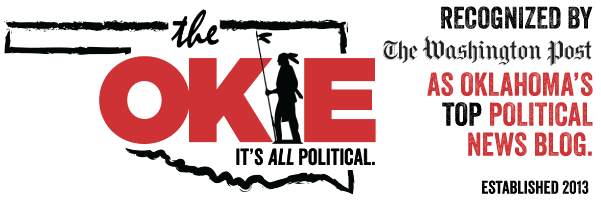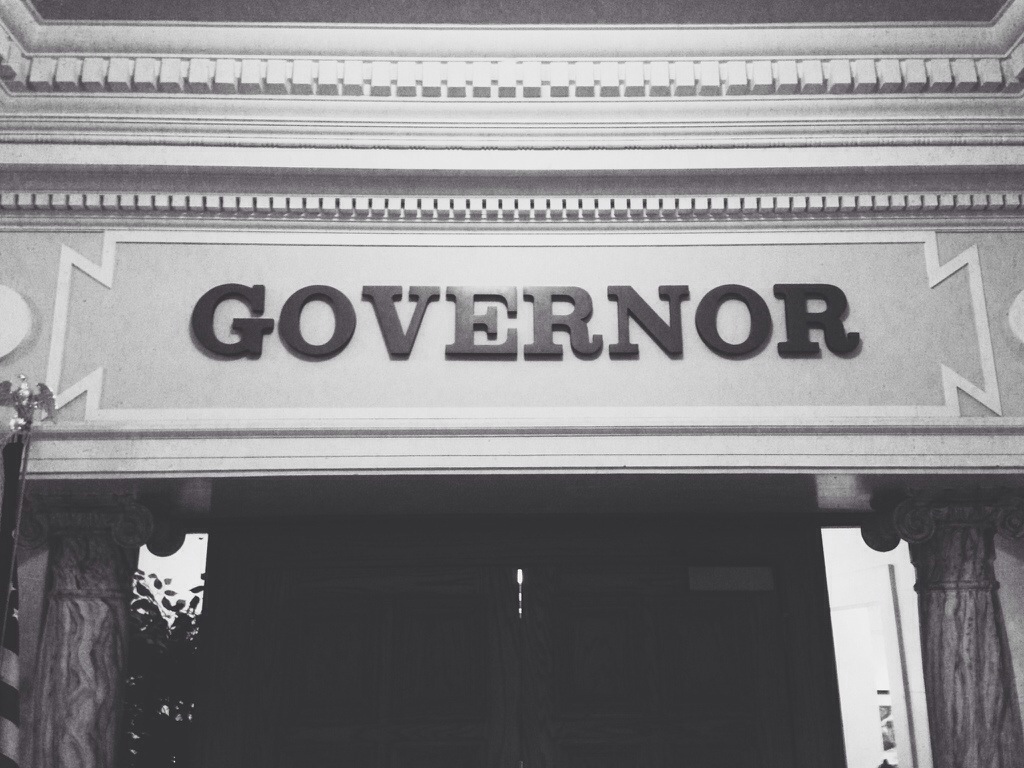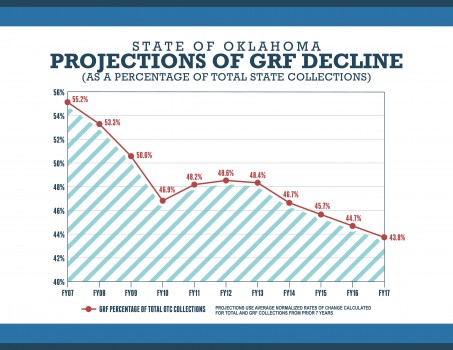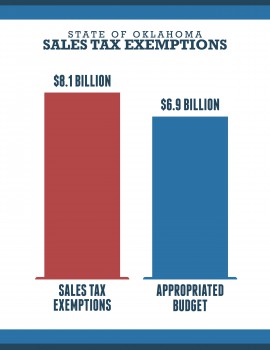TEXT & GRAPHICS: Governor Fallin Delivers 2016 State of the State
Governor Mary Fallin State of the State
Delivered: 2/1/16
Lieutenant Governor Lamb, statewide elected officials, Speaker Hickman, President Pro Tem Bingman, members of the court, honorable senators and representatives, Cabinet members, tribal leaders, distinguished guests, and citizens of Oklahoma:
It is my duty as well as my great honor to be here today to discuss the state of our state.
Before we begin, let’s acknowledge two great Oklahomans and irreplaceable public servants who were in this chamber last year but aren’t with us today: Representative David Dank and Labor Commissioner Mark Costello. We lost David in April and Mark in August. Though they are not physically here, the work they did is everlasting. We do have Mark’s wife, Cathy, and two of their children, Anna-Marie and Ian, in the chamber today.
Thank you, Cathy, for your efforts to improve our mental health delivery system.
I’m joined today by my family – my husband Wade and several of our wonderful children.
Thank you for your love and support.
Oklahoma’s economy
This session, there are huge challenges before us. Our oil and natural gas sector has been damaged in market warfare on multiple fronts. Domestic energy producers are hurting, and when they hurt, Oklahoma hurts, too.
I’m reminded of five years ago, when I gave my first State of the State address. We faced a number of difficult circumstances then as we started climbing out of a national recession. We worked hard to forge a more prosperous state. Just two years ago, we had the fourth-fastest-growing economy in the nation. Our savings account, the Rainy Day Fund, had grown to $535 million – quite an improvement over the $2.03 that was left remaining in the fund when I took office in 2011.
And today, as Yogi Berra was fond of saying, “It’s like déjà vu all over again.”
Now, just as then, we’re seeing some jobs disappearing in the wake of an economic crisis that is largely out of our control. We’ve seen a 70 percent drop in oil prices in less than two years, which has a tremendous impact on our revenue. There is an excess supply of oil and natural gas in the marketplace, and instability in worldwide markets doesn’t help.
It’s a tough world out there. And it’s easy to get discouraged or become timid.
Many of us have heard the old saying, “Never let a crisis go to waste.” We can use our budget crisis to create new opportunities to build a solid foundation for Oklahoma.
We can do it.
First, we must start with the budget. The oil price collapse and decades-old structural problems with the budget have caused almost a billion dollar budget hole. How we respond will define our future more than anything else.
We have tough decisions ahead, folks. We need to roll up our sleeves and do the hard work.
But, if we work together, we can overcome this. We can do it.
Changes in budget structure needed
Even in this fiscal climate, we can pass a budget that begins the type of true, meaningful fiscal reform the state needs. That’s the type of reform proposed in my executive budget.
But first, I want us to consider why we need bold action on the budget. In front of you there is a spreadsheet with three approaches to the budget. Each column is marked with the colors of a common traffic light – red, for stop; yellow, for caution; and green, for go.
Take a look at the red column first.
This shows what happens if we take no action. If we don’t change the way we apportion and collect revenues, most state agencies will be faced with a 13.5 percent appropriation cut for the upcoming 2017 fiscal year – or a total cut of 16.5 percent since July 1, when considering December’s revenue failure.
This approach would, for example, cut common education funding by $330 million next year. $330 million dollars. We can all agree this is an unacceptable path. It’s not the path I want Oklahoma to take. I know we can do better.
Now look at the yellow column. This is a quick and easy shortcut – often used in the past – that withdraws every penny available from the Rainy Day Fund to reduce agency cuts to 10 percent. But that’s still a $244 million cut to public education that we can all agree is not acceptable. The path in the yellow column isn’t one Oklahoma should go down, either.
The green column shows the budget I propose. This budget takes control of the challenges we face today and puts us on far better footing for the future.
It makes necessary cuts that will require continued efficiencies from agencies, prioritizes spending and lessens those reductions in our core service areas wherever possible. It modernizes our tax code to make it more consistent with 21st century commerce.
Because this budget proposes using recurring revenue, it uses zero one-time revenue. You heard me right: There is no one-time money in this budget.
It doesn’t even use the Rainy Day Fund. We need to keep the Rainy Day Fund as flush as we can because the energy sector downturn may last longer than anyone ever expected. We need to budget accordingly.
While we can’t control the price of oil, we can control our budget. Let’s truly take charge of the budget this session.
We can do it.
My budget addresses structural imbalances, fixes problematic tax policies, prioritizes spending and puts recurring, stable revenue on the table. This is the type of budget I want you to send me for approval. It will require hard work and important votes. It will be the right thing to do for future generations of Oklahomans.
In my budget, we acknowledge the revenue downturn we’re in and we make strategic cuts to agencies. Most agencies will see an appropriation reduction of 6 percent. That’s not pleasant, but it’s a far better position than 13.5 percent or 10 percent across the board and depleting our savings account.
We can do it.
$910 million in recurring revenues
This budget makes specific recommendations for capturing $910 million of recurring revenues for appropriations that will help fund core services next year and every year in the future.
Of that $910 million, my budget proposes $181.6 million from a personal consumption tax on cigarettes.
Smoking is Oklahoma’s leading cause of preventable death and it costs our state $1.6 billion in related health costs each year. Our smoking rate has dropped 19 percent since I took office, but one in five Oklahomans still smokes. This is the most important thing we can do to improve Oklahoma’s health ranking.
- Beyond that proposal, my budget has $729 million in other revenues for appropriations.
I’m offering bold, specific solutions to fix our budget. Here they are: - $125 million to come from non-appropriated agency revenue sharing. Some non-appropriated agencies remit a portion of their fees, fines and other revenues back to the General Revenue Fund for appropriation. Others do not.
- $19.7 million a year by eliminating non-statutory, non-critical pass-through appropriations.
- $125 million a year by passing Representative Tom Newell’s legislation automating reconciliation of some agency revolving funds, which usually contain about $1.5 billion. The transfer of monies from these accounts is often mischaracterized as one-time revenue, despite the fact the majority of these accounts replenish yearly. These funds are there every year – they are not one-time funds – as evidenced in the chart on my RIGHT.
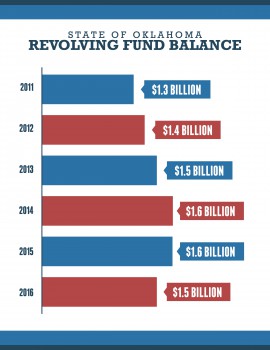
- $40 million a year by reallocating apportionments back to the General Revenue Fund that currently go to noble but noncritical functions. Remember, just a few years ago, 55 cents out of every dollar we collected went to the General Revenue Fund. Today, just 45 cents out of every dollar collected goes there, and it is continuing to decline. You can see this on the chart in FRONT of me.
And finally, $200 million a year by modernizing our state sales and use tax exemptions. The sales tax code in Oklahoma today isn’t much different than it was in the 1980s despite huge changes in the way commerce is conducted and the way consumers purchase goods and services. Reading our sales tax code is like watching a VHS tape when you can use Netflix. Modernizing the sales tax code means keeping the same low rates and applying them in ways that better reflect today’s commerce and consumer behaviors.
We can start with taking a look at the $8 billion – that’s billion, with a B – in annual sales tax exemptions. We exempt more in sales taxes than we appropriate each session, as you can see in the chart on my LEFT.
We’ve asked around and nobody can remember any of these ever getting repealed, let alone reviewed. Surely some of that $8 billion can be revisited. Just 1 percent would net $80 million to core government services.
This budget proposes eliminating outdated exemptions and looking at areas other states apply sales tax to that aren’t subject to sales tax in Oklahoma. The Texas sales tax covers roughly 60 more categories than Oklahoma’s. New Mexico’s sales tax covers 130 more categories than Oklahoma’s.
The services component of the economy has for decades been the fastest growing segment of the U.S. economy and our tax code does not reflect that.
If we don’t adjust our tax structure to reflect this change in commerce, there will be increasing pressure to raise government revenue in less palatable ways. If structured properly, this approach could present an opportunity to reduce the state sales tax rate, which is currently the sixth-highest in the nation.
Mayors and city councilors, this will help your cities fund essential services like police and fire. We’ll need your help to get it done. We all know that cities and states are losing out on sales tax revenue each year as more business is conducted online, and states like Oklahoma can’t collect sales tax because of federal inaction. We all need to call on Congress to level the field for small businesses and Oklahoma retailers by implementing a fair system for online sales tax. We have to help our local communities keep local businesses healthy and fund core services.
So those are some of the recurring, stable, real revenues in my budget.
I think these ideas are good for Oklahoma and have bipartisan appeal. Democrats and Republicans can support them because we both want to fund core government services.
Taxpayers can support them because they expand the tax base so we can keep tax rates low now and in the future to maintain competitiveness in our pursuit of new businesses and a more prosperous state.
These proposed revenue streams lay a solid foundation to enhance outcomes and elevate opportunities. And finally, it’s important for future governors to have better, more stable revenue streams than I did so policymakers, agencies and the public aren’t faced with constant revenue uncertainty.
So that gets us to the expenditure side of my budget.
As I said, we have to face the revenue reality. Most agency appropriations in this budget are reduced by 6 percent. However, the reductions are smaller for critical core service agencies. The following agencies will receive a 3 percent reduction:
- Department of Human Services
- Health Department
- Health Care Authority
- Mental Health and Substance Abuse Services
- Department of Public Safety
- Oklahoma School of Science and Mathematics
- and the Office of Juvenile Affairs
There are three targeted appropriation increases in this budget. Each is related to the three pillars of my administration’s second term. As I shared in this speech last year, my top priorities for Oklahoma in this second term are improving education, reducing the state’s incarceration rates, and improving its health outcomes. Those priorities are reflected in my budget and the policy proposals I’m most interested in this session.
More money for our state prisons
The first involves our state prisons. The situation in Oklahoma prisons is very serious. Due to the revenue failure declaration, the Department of Corrections will run out of money this fiscal year. To prevent that, the department would have to make cuts causing it to house prisoners in unsecure areas, furlough correctional officers and other undesirable outcomes. Correctional officers put their lives on the line. We have to help them. For the sake of public safety, we have to get additional money to the Department of Corrections.
This budget proposes the Department of Corrections receive an annualized $20 million supplemental appropriation this year and a $10 million appropriation increase next year to address continued offender growth and help keep the public safe.
But it’s a fact that Oklahoma is still Number One in female incarceration and we’re consistently in the top five in male incarceration. Again, this has been a decades-long problem.
Today, I’m calling for serious sentencing changes that will preserve public safety while helping control prison costs and reduce incarceration rates.
Let’s acknowledge the elephant in the room. Oklahoma’s drug possession sentences haven’t deterred substance abuse and have filled our prisons to over capacity. These sentences, while well intentioned, tend to send some nonviolent offenders into prison for years and years, where they live alongside violent offenders whose bad influences can make nonviolent offenders worse.
- This session, I’m calling for lowering Oklahoma’s mandatory drug possession sentences.
- First, let’s allow district attorneys to have the discretion to file any first drug offense as a misdemeanor.
- Next, we lower the mandatory sentence from two to 10 years in prison, to zero to five years in prison.
- For second felony offenses for drug possession, lower the mandatory sentence from two years to life, to zero to 10 years.
9 - And for third felony offenses for drug possession, lower the mandatory sentence from six years to life with no probation to zero to 15 years.
- For property crimes, let’s raise the value of a felony crime from $500 to $1,000. The $500 benchmark has been in place since 2002, and it needs to be raised. A teen who steals someone’s smartphone today could be branded for life as a felon because smartphones cost more than $500; twenty years ago, most cell phones cost less than $100.
My 40-member task force of law enforcement professionals recommended these proposals, which if fully implemented could prevent thousands of people annually from being a felon for life, which makes it harder for them to get a job and many times leads to the breakup of their family. State prisons are at 119 percent capacity. We just can’t keep doing what we’ve been doing. It’s not working.
We must also enhance law enforcement’s ability to protect Oklahomans. We can make law enforcement stronger and more efficient while keeping the public safe by consolidating targeted law enforcement agencies.
Fully funding the Pinnacle Plan
The second area receiving additional funds in my budget is the health and well-being of children through the Department of Human Services. This budget sends DHS $11.3 million to fully fund the Pinnacle Plan. It’s important to keep our commitment for the sake of the thousands of Oklahoma foster children who deserve better futures than they would have otherwise.
Late last year, I launched an initiative called Oklahoma Fosters that encourages people to foster or adopt children in state custody. The Oklahoma Fosters program is working.
One of our great Oklahoma families that answered the call to serve is the Siemens family of Tulsa. Brian and Chris have both stepped up to foster seven children and adopt three in addition to having their own biological children. They are hard-working individuals, community advocates and have big, beautiful hearts. Thank you, Brian and Chris, for helping Oklahoma’s children. Please stand up so we can recognize you.
Education is biggest priority
Next, Oklahoma’s future sits in the classrooms of today. The education of our students remains my biggest priority in my budget, even in fiscal climates like this.
I support and I know my fellow Oklahomans overwhelmingly support giving our teachers a pay raise.
This budget appropriates $178 million in new money for a permanent $3,000 teacher pay raise for every teacher in this state. And we can do it without raising the state sales tax rate to the highest level in the nation.
We can do it. I’m excited about it.
Time to bring the dinosaur out of the closet
Now I want to talk to you about the old dinosaur nobody will bring out of the closet. Just as I talked earlier about the decades-old structural budget problems, it’s time to have an honest discussion about the decades-old structural problems of our education system and how we can give our children the quality education they deserve.
Listen to the words of a former governor when I sat on the back row in this very chamber as a young legislator 23 years ago – “We need more dollars in the classroom. We need fewer school districts. Real education improvements are impacted by better organization at least as much as through additional revenues. It’s unrealistic to force everyone in the state to fund local school inefficiencies.”
And that was said by former Governor David Walters, a Democrat, in his State of the State address in 1993. My, how things haven’t changed.
It’s time to consolidate the administrative costs of the state’s underperforming K-8 dependent school districts by putting them into existing Pre-K-12 school districts. To be clear, this does not mean closing rural schools. This would get more money to classrooms and can enhance educational outcomes in a more effective way. We must ensure that our students are provided the highest quality instruction through advanced curriculum and facilities.
To help weather this energy sector downturn’s effect on school funding, let’s give school districts the flexibility to use their building funds for teacher pay and benefits if local officials determine it is prudent and meets their most pressing needs. This would free up $200 million at the local level that is currently restricted for other uses. This isn’t a panacea and it won’t be used by every district, but giving this flexibility will help schools.
It will modernize the use of the ad valorem tax base and give districts more flexibility to meet their real needs. This would make a huge difference to our schools.
And in times like these my Oklahoma Works initiative is more important than ever with developing partnerships between schools, local businesses and other key partners with its intent to boost educational attainment and better align workforce to the needs of employers.
Finally, I’m 100 percent supportive of Education Savings Accounts. 100 percent.
All students learn differently and should have the opportunity to attend a school that has the best environment for each student to be successful. This can be accomplished through Education Savings Accounts, while still protecting school finances. Senator Clark Jolley and Representative Jason Nelson have legislation on this issue. Send it to me and let’s give students and parents a better chance for educational success than they have today.
I do recognize these are some of the hardest things I’ve ever asked for your help to accomplish as governor. But they’re also some of the most important. We were sent here to lead, and we need to lead now more than ever.
We have smart, capable people in this room and throughout state government. We can do this.
Finish repairing, renovating the state Capitol
Now here’s one more big lift. It’s this building.
Thanks to your action two years ago, we’ve finally started the Capitol restoration. We have contractors on site fixing this irreplaceable building that has been literally crumbling around us for far too long. We’re making the People’s House safe to visit and work in again. It’s one of our top tourist destinations, it’s the seat of our government and we’re finally on a path to treating it as such.
We’ve always known the $120 million bond issue you passed two years ago was a start, not a finish. The contractors have told us they think it will take around another $120 million to complete this important job.
Let’s finish the Capitol’s most pressing needs. In 2017 we will celebrate with a party this building’s 100th birthday. No one should want to stop construction. Interest rates remain low, and the new bond wouldn’t be issued until 2018, when 40 percent of our existing bond principal rolls off the books, so we can do this in a way that doesn’t affect next year’s budget. This is a legacy opportunity for you all. Let’s finish the job right.
Oklahomans are known for their can-do spirit, from the days of the land runs, to the booms and busts of our economy, to moments that shook our core sense of well-being. We are at our best during our most challenging times. We can do it.
Many challenges have been overcome in the past five years
If you think back over the past five years, we’ve overcome many challenges, and we’ve had many successes.
- In 2011, Oklahoma’s unfunded pension liability was $16 billion. But we cut that nearly in half; it stands at about $8.8 billion today.
- We made Oklahoma more business friendly when we enacted tort reform measures, moving Oklahoma from 42nd to 33rd in reducing frivolous lawsuits.
12 - We transitioned Oklahoma to an administrative workers’ compensation system taking care of injured workers while also saving over $368 million for businesses since 2012.
- We greatly enhanced cybersecurity and technology efficiency by reducing technology expenses by $100 million.
- We decreased structurally deficient bridges from more than 700 to about 340, and we’re on track to fix the remainder by the time I leave office in 2019.
- We’ve increased the number of degrees and certificates and beat our goal by averaging 2,788 additional degrees and certificates a year, building a better-educated workforce. We also reached a record high last year in the number of STEM – science, technology, engineering and math – degrees and certificates, with a 28 percent increase over the last five years.
- We enacted the Reading Sufficiency Act, which I have long championed and has helped elementary school students bolster their reading skills. State fourth graders improved their reading scores by five points in 2015, putting Oklahoma above the national average with the third-most significant state gains in the country.
- We implemented an A-to-F grading system for our public schools, which serves as a guide for parents and school district patrons to know how their schools are performing. It’s also helpful for school districts and teachers, because it allows them to see where they should focus on improvements and adjustments. Today, I’d like to recognize the administration and staff of the Gore School District. Gore Elementary School took the results of the grading system and improved the C score it received in 2013 and improved it to an A+ rating. Gore Upper Elementary has also improved its scores – going from a D- in 2013 to a C+ in 2015. I appreciate the hard work of the faculty and students, some of whom are with us here today, and I ask that they stand and be recognized.
- We provided the highest funding for mental health in state history, and we enacted historic legislative action to decrease prescription drug and substance abuse-related fatalities, and
- We let taxpayers keep more of their hard-earned money through responsible state income tax reductions.
Yes, we’ve faced tough challenges before, and by working together we can solve today’s problems, too.
We can do it, and we’ve done it before.
Oklahomans do the hard work day in and day out.
Just look at our first responders who, in the past year alone, have provided world-class responses to floods, tornadoes, blizzards and ice storms. My thanks especially to those who worked in the ice storms on Thanksgiving and Christmas weekends. So many sacrificed their own safety and did what it took to keep their fellow Oklahomans safe. That is what’s known as the Oklahoma Standard.
These Oklahomans are the real heroes. We need to do them justice by doing our jobs here at the Capitol so they can keep doing theirs.
In closing, I want to share something truly special with you. I mentioned earlier that it’s a tough world out there. It really is, especially for our men and women in uniform.
For the first time since I’ve been governor, no Oklahoma National Guard units are deployed overseas. Since 9/11, the Oklahoma National Guard has answered the call over and over again to protect our homeland and defend liberty. Please give them a round of applause for their continued service to our country.
I look forward to a productive session working with all of you. Thank you for your service. God bless you, and the state of Oklahoma.
###
